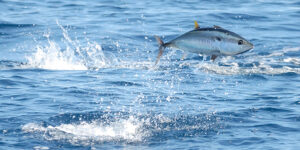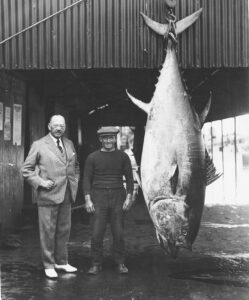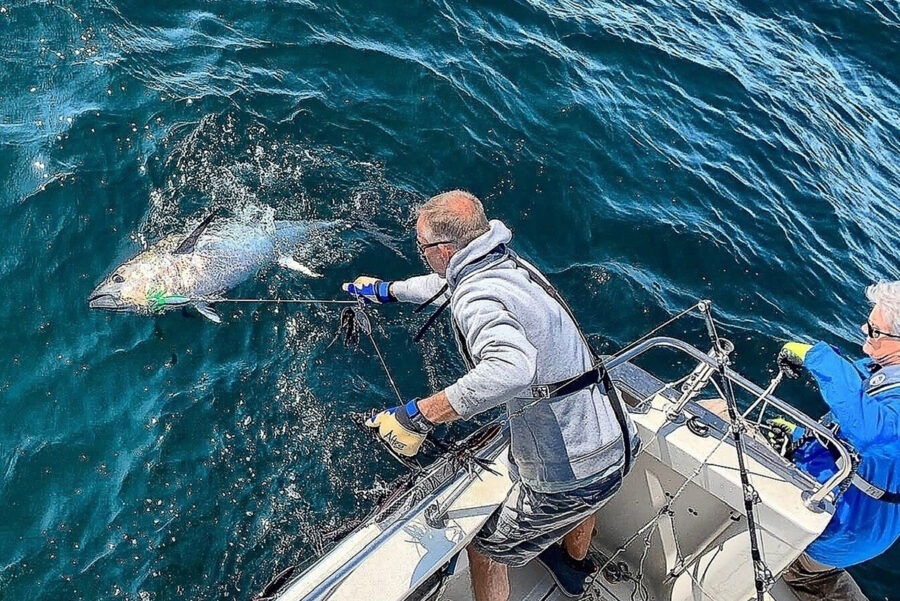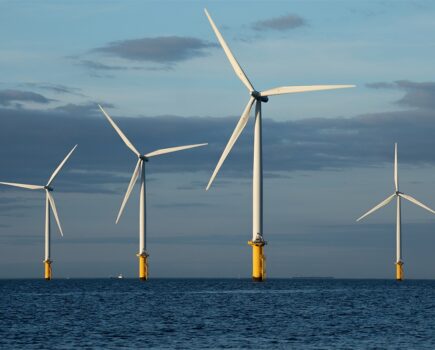Twenty-eight skippers and their crew from ports across South West and southern England will make their first trip of the 2022 season on 15 August to catch, tag, and release Atlantic bluefin tuna (BFT).
The vessels are taking part in the Defra-funded scientific ‘catch, tag and release’ (CHART) programme, which aims to provide important scientific data to help understand and manage Atlantic bluefin tuna while benefiting coastal communities.

A juvenile bluefin feeding – an increasingly common sight off the South West coast, where what they’re feeding on is the fish that rod and line fishermen are targeting. (Photo: Frederic Bassemayouss)
After a successful pilot in 2021, the programme has received funding for another year in 2022 and offers an exciting opportunity for recreational anglers to legally encounter these ocean giants.
Atlantic bluefin tuna are known for being amongst the biggest and fastest fish in the sea. They are also one of the most valuable, as anyone watching the National Geographic series Wicked Tuna will be all too aware, with individual fish, flown to the lucrative Japanese sushi market, sometimes worth in excess of £10,000 each. This value contributed to overfishing and their rapid decline on the Atlantic seaboard of America, as well as in the Mediterranean.
UK stocks crashed in the 1970s, when pelagic fish stocks collapsed due to overfishing, and have only recently been able to recover, after conservation efforts across the Atlantic have seen bluefin numbers rebuild from almost zero in the last decade.
In a statement celebrating the opening of the tagging season, Cefas said: “In recent years, the number of reported sightings of BFT in UK waters has been increasing. This has led to a growing interest in the species from the science community, recreational fishing groups and the commercial fishing sector.
“Despite historic evidence of captures around the UK, we know relatively little detail of their day-to-day movements and behaviour, for example how long they stay in British waters and where they go once they leave our coastal environment.
“CHART brings together a breadth of fishing, science and conservation interests in a collaborative, innovative approach to tuna scientific research. The data collected will contribute not only to improving understanding of Atlantic bluefin tuna in English waters but will also be supplied to the International Commission for the Conservation of Atlantic Tunas (ICCAT).”
Welcoming the programme, and the additional knowledge that this research will provide, environment secretary George Eustice said: “The return of Atlantic bluefin tuna to UK waters is welcome news, and it is important we get the data to properly understand this through a catch, tag and release programme.
“We are backing an expanded scheme this year, and its findings will help inform the future management of this highly valued species, in line with our commitment to making sure our marine environment is protected.”
Cefas senior fisheries scientist Sophy Phillips said: “Scientific research and citizen science projects have provided evidence that Atlantic bluefin tuna are returning to UK waters in increasing numbers during the summer months. But we still don’t understand enough about these amazing predators; CHART offers the potential to fill gaps in our knowledge of their distribution, movements, behaviour, numbers and demographics.
“Training vessel skippers and their crew in scientific techniques so that they can tag the Atlantic bluefin tuna, as well as collect data on their size, fishing effort and sightings, will enable us to develop a clearer picture of BFT in English waters.”

A bluefin landed in around 1935 on the Yorkshire coast, where a big-game fishery attracted the rich and famous between the wars.
In 2021, the first year of tagging, 704 tuna were tagged, in a total 2,881 hours of fishing effort – one every four hours. The boys fishing in the US commercially, documented on Wicked Tuna, would be envious! In spite of extremely strict quotas, licence limits and a well-documented recovery of stocks after years of overfishing, their catch rates are a fraction of this.
Results in 2022 are expected to be even more impressive. Additional vessels have joined the programme, and FN has heard multiple reports that the tuna have arrived in July, a week or two ahead of some previous years, and in abundant numbers. Rumours of a bluefin inside Plymouth harbour last week abound, though FN has been unable to track down any pictures that confirm this.
The setting up of the CHART programme has involved close collaboration between Defra, Cefas, the MMO and a steering group representing a wide range of angling and conservation interests – though without the involvement of any group from the commercial sector.
Ross Parham, who operates a 12m catamaran from Brixham, said: “As a returning skipper from CHART 2021, I am delighted to be chosen again for CHART 2022. In my opinion, the South West of England has one of the best big-game fisheries in the world with the BFT that we are lucky to have in our coastal waters, so who would not want to be a part of that!
“The Cefas team are brilliant, and to see professional skippers working together with scientists makes for some great results and useful data.”
Bespoke workshops on the programme, led by Cefas scientists and sector experts, were held in Falmouth and Plymouth in July. Attendees included skippers and crew, and Cefas, MMO and Defra staff.
One participant told FN: “The training was excellent, and covered everything from tagging processes to fish handling, and the type of gear that is best to use, all the way through to ensuring that we can also help participating anglers and ensure their safety, and understanding of the tagging programmes as well.”
Although some of the vessels involved are registered and operate at other times as commercial fishing vessels, no bluefin caught under this programme can be landed, and strict protocols to ensure minimal stress and handling of fish are in place.
Like commercial fishing boats in the UK, recreational sea anglers are not permitted to target bluefin tuna outside of the CHART programme, and must release any unintended catches immediately and unharmed.
Fishing News hopes to run a feature on the fishing and tagging as the season progresses.
This story was taken from the latest issue of Fishing News. For more up-to-date and in-depth reports on the UK and Irish commercial fishing sector, subscribe to Fishing News here or buy the latest single issue for just £3.30 here.








